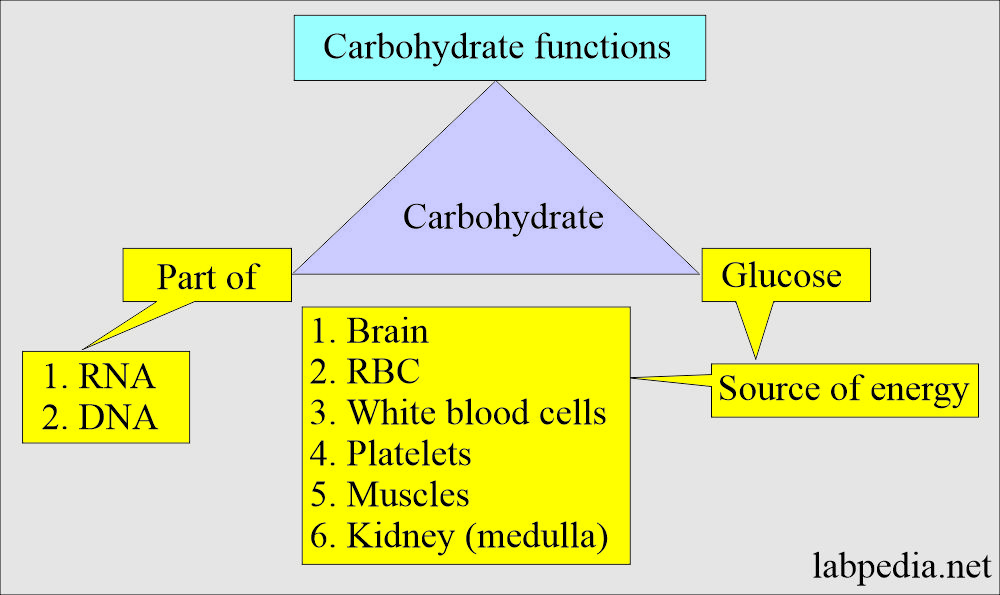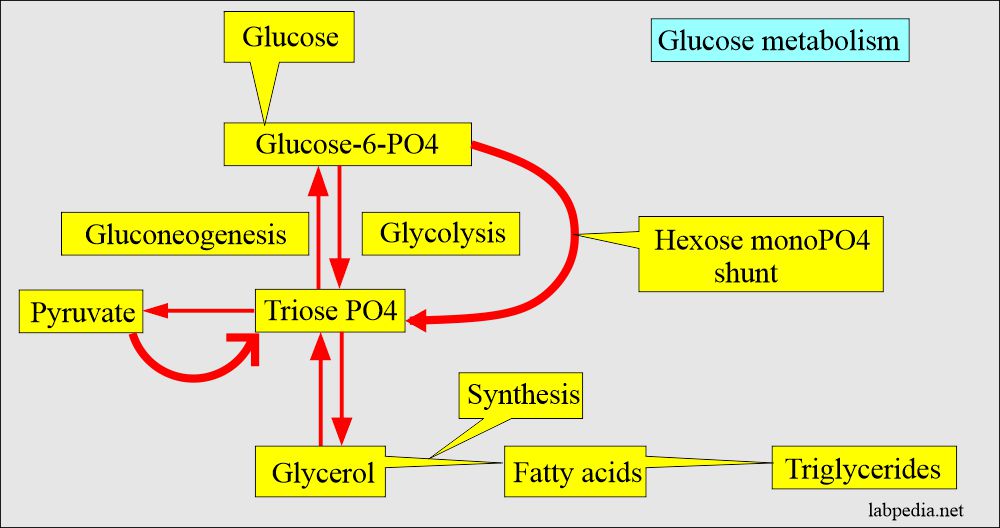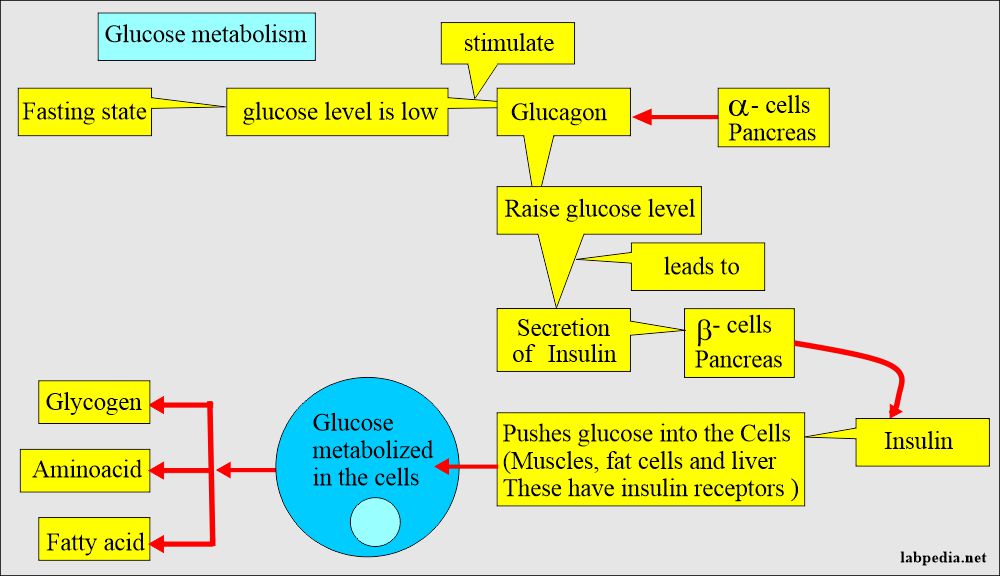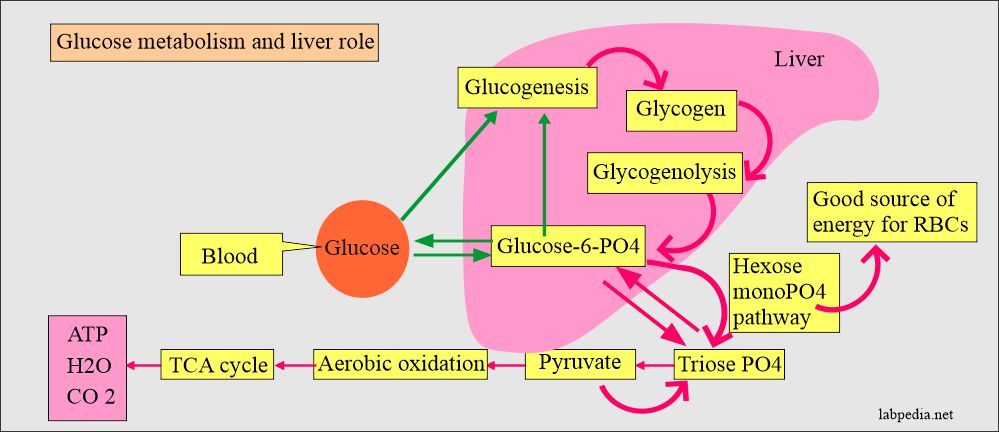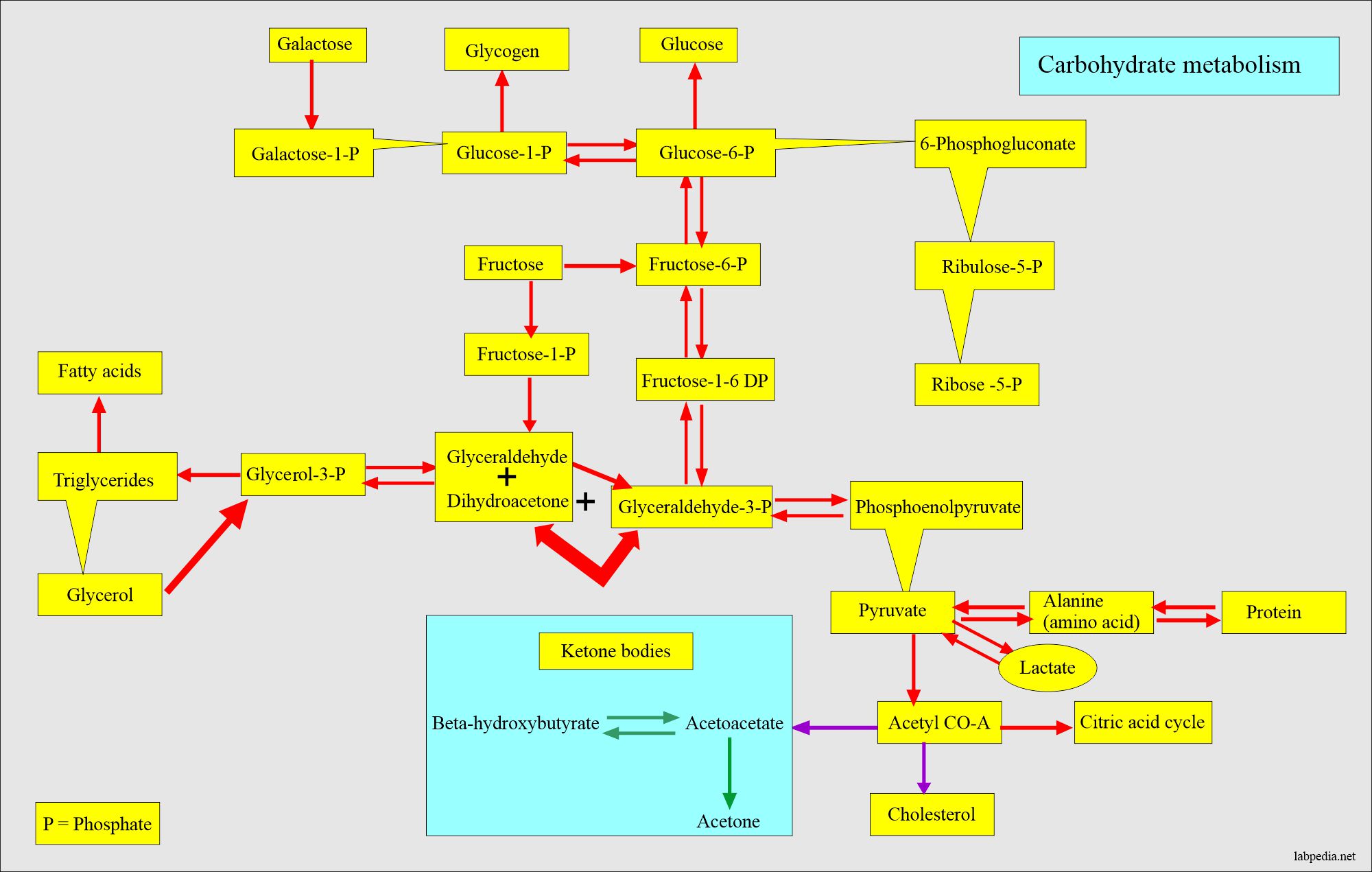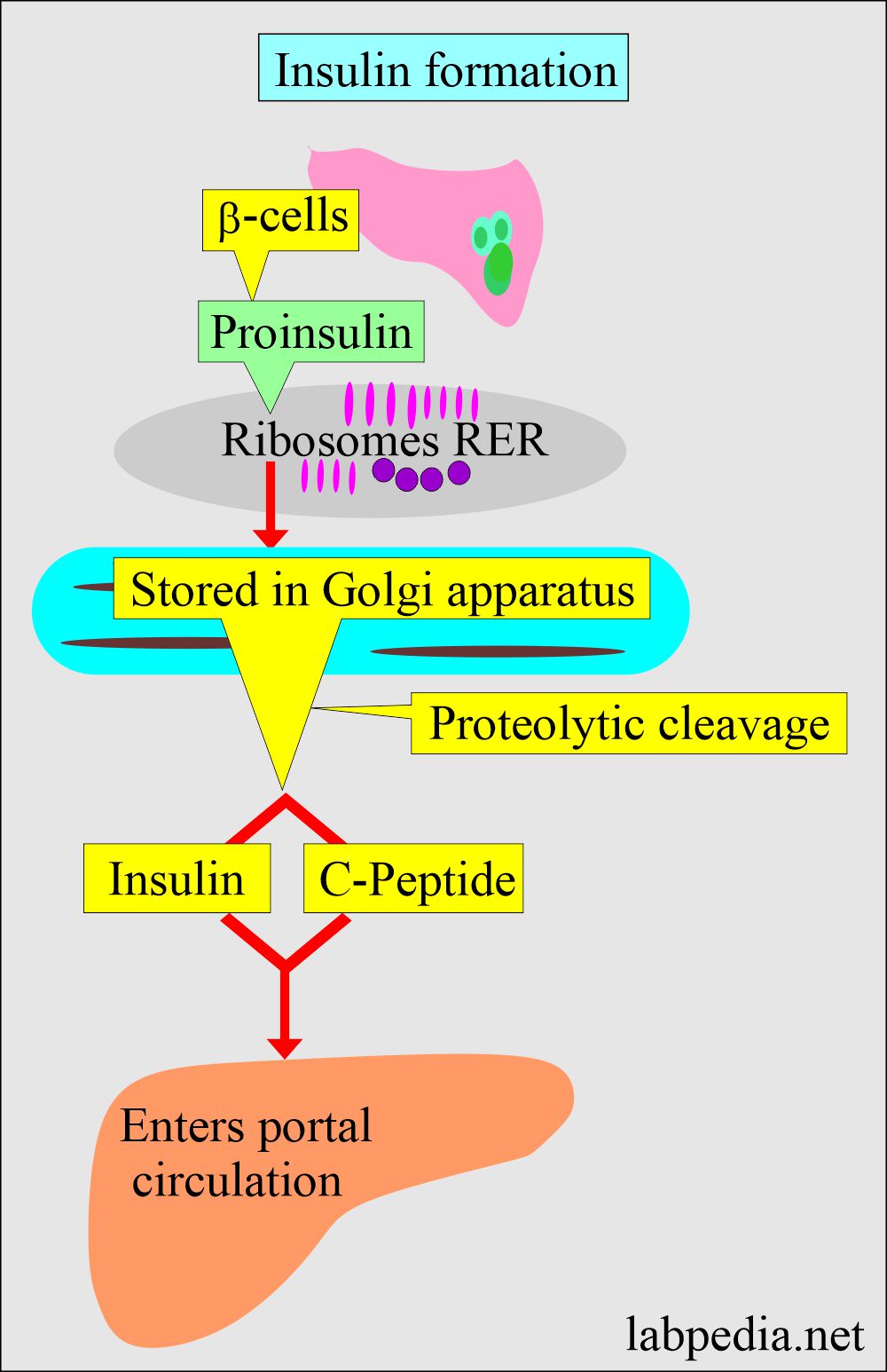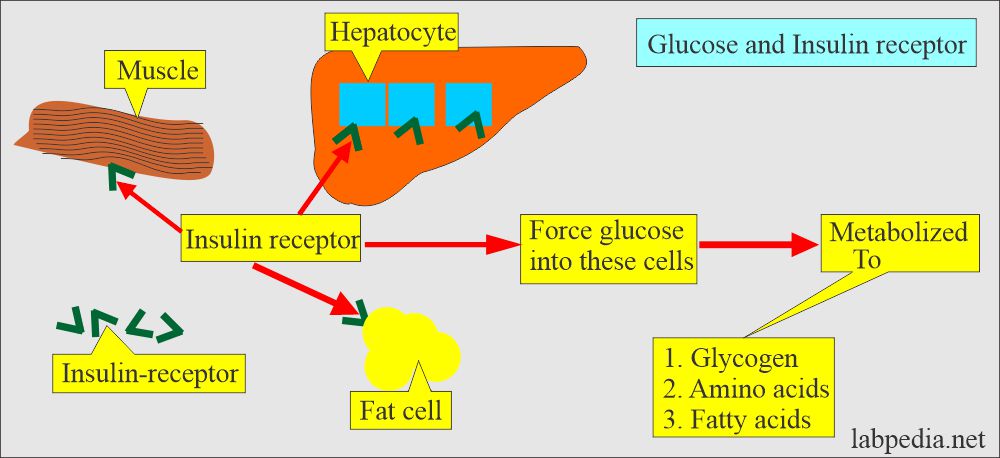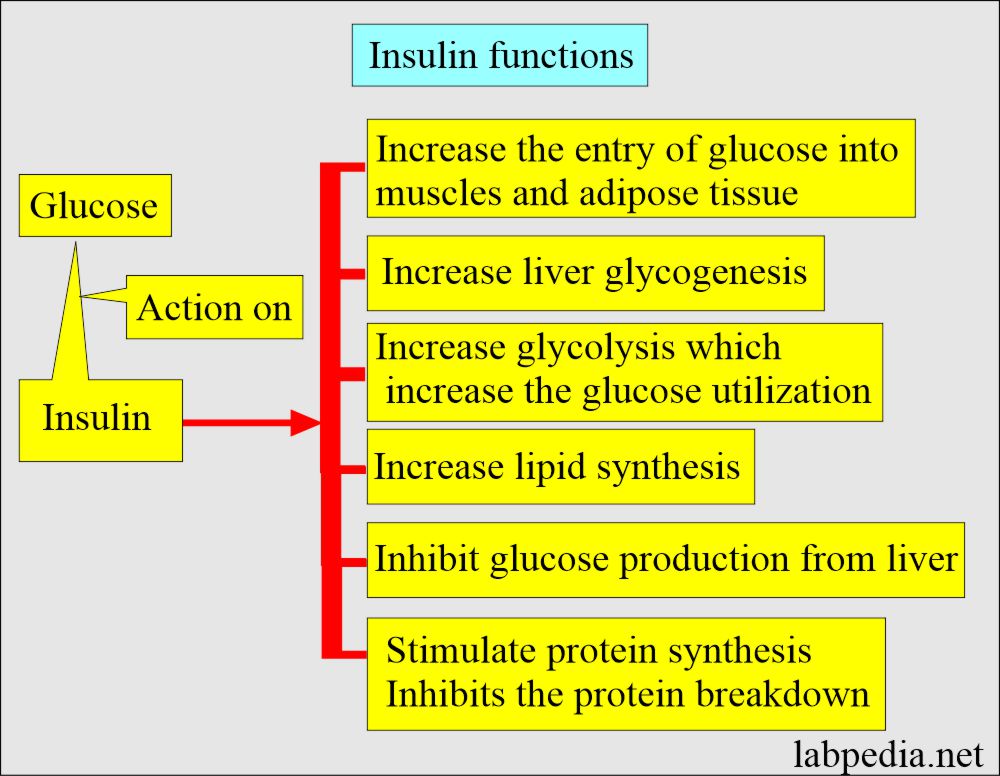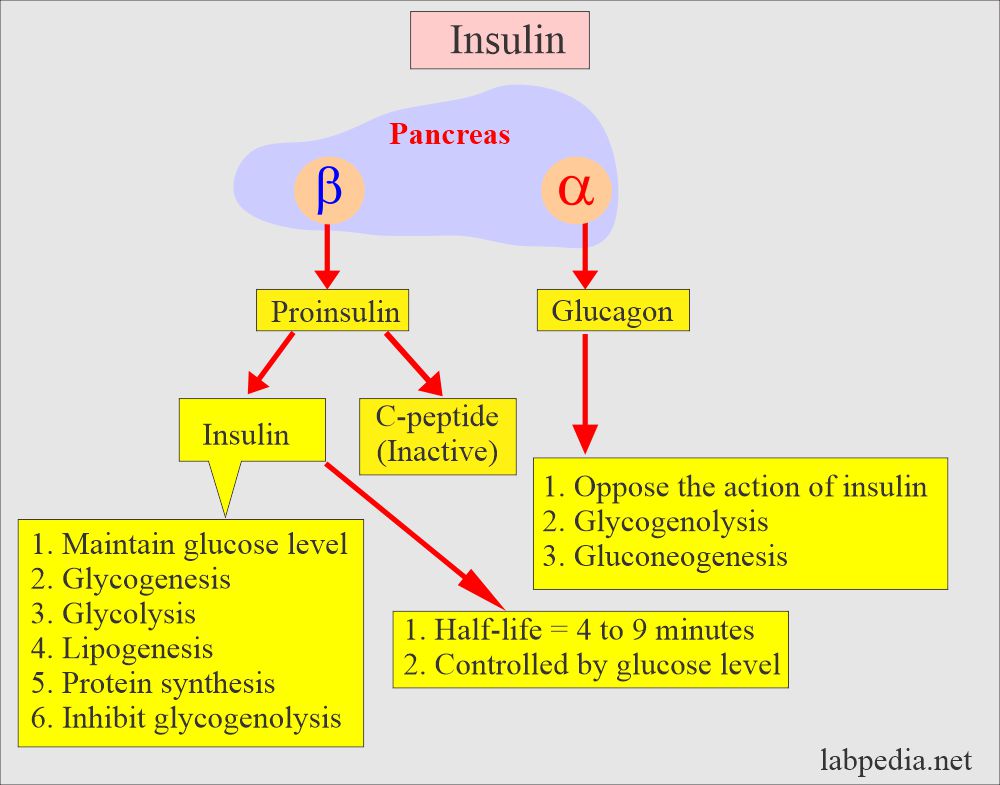Diabetes Mellitus:- Part 1 – Carbohydrate and Glucose Metabolism, Insulin and Glucagon
Carbohydrate and Glucose Metabolism
What Sample for Glucose Estimation is needed?
- This test can be done on serum. The serum should be separated within 30 minutes of collection.
- The Serum can be stored at 25° C for 8 hours and 72 hours at 4 °C.
- Oxalated blood can also be used. Preservative sodium fluoride may be added.
- The plasma can be stored at 25 °C for 24 hours (with preservative sodium fluoride).
Stability of the sample for glucose level
- One ml of blood in anticoagulant will be stable for 3 hours with fluoride.
- Oxalate plasma is stable at 2 to 8 °C for 48 hours.
- Mainly, serum is used, stable for 8 hours at 25 °C and 72 hours at 4 °C.
- A fast of 6 to 8 hours is required for a fasting sample.
What are the Indications for glucose estimation?
- This test is done to diagnose diabetes mellitus.
- This test is also done to evaluate and monitor diabetes mellitus.
Pathophysiology of the Carbohydrates
- Carbohydrates are major components of the diet and are an essential energy source.
- Glucose is controlled by insulin and glucagon.
- Glucose is low in the fasting state.
- The glucose = C6H12O6 = C6 (H2O)6.
- Lactose = C12H22O11 = C12 (H2O)11.
- The capacity of the body to store the carbohydrate is limited:
- The liver can store only 10% of its wet weight.
- Muscles can store 5% of their wet weight.
- This store amount is only sufficient for half a day.
- Carbohydrates include sugar and starch.
- The salivary gland enzyme converts starch and glycogen into dextrin and maltose.
- The acid pH of the stomach inhibits salivary amylase.
- Pancreatic alkaline secretion of amylase acts mainly on maltose and the disaccharides.
- Maltose, lactose, and sucrose are converted into:
- Glucose.
- Galactose.
- Fructose.
What are the functions of carbohydrates?
- CHO are the components of RNA and DNA.
- CHO is the Source of energy, which is glucose.
- Under fasting conditions, the following organs depend only upon glucose as a source of energy:
- The brain is the main organ dependent on glucose.
- Red blood cells.
- White blood cells.
- Platelets.
- Kidney medulla.
- Increased glucose level leads to its storage as glycogen in the liver.
- Decreased glucose level leads to glycogenolysis and forms glucose from the glycogen.
Glucose Metabolism:
- The breakdown of the following forms glucose:
- Grains.
- Starchy vegetables.
- Legumes.
- Body store of glycogen.
- Endogenous proteins.
- Excess glucose is converted into fat by adipose cells and stored in the adipose tissue.
- The Triose pathway is the main junction where four pathways intersect and help to maintain the glucose level.
- This is a complicated enzymatic system, but the glucose level is maintained in the normal range.
- The following diagrams show that glucose metabolism is interlinked with fats and proteins.
- Glucose levels are controlled by insulin and glucagon.
Pathophysiology of Glucagon and Insulin
Glucagon
- Glucagon is produced by the Alpha (α) cells of islets of Langerhans in the pancreas.
- Glucagon is 29 amino acids polypeptide.
- The major target organ is the liver, which binds to a specific receptor and increases intracellular adenosine-5-monophosphate and calcium.
- Glucagon stimulates the production of glucose in the liver by glycogenolysis and gluconeogenesis.
- It also increases ketogenesis in the liver.
- The minor target organ is fat, which causes lipolysis.
- Glucagon secretion is controlled by glucose level.
- A low glucose level is stimulatory.
- A high glucose level is inhibitory.
- In the case of fasting, protein, and fats are broken down into glucose under the influence of Glucagon.
- In the case of long-standing diabetes mellitus, it impairs the glucagon response to hypoglycemia, leading to increased chances for hypoglycemia episodes.
- Insulin inhibits glucagon secretion from the pancreas.
Insulin
- Insulin is produced by the beta cells of islets of Langerhans in the pancreas.
- Insulin is an anabolic hormone.
- First, proinsulin is formed in the ribosomes of the rough endoplasmic reticulum.
- Later on, stored in the Golgi apparatus.
- Proteolytic cleavage forms Insulin and C-peptide.
Insulin and Diabetes mellitus:
- It results from the abnormality in the production or use of insulin.
- β-cells of the pancreas produce insulin, and the involvement of these Β-cells abnormality leads to diabetes mellitus:
- β-cells insulin production is deficient.
- Normal synthesis but abnormal release.
- Extra-pancreatic factors are like peripheral tissue cell receptor dysfunction, producing resistance to the cellular action of insulin.
- Non-pancreatic hormones will affect insulin secretion or blood glucose metabolism.
- C-peptide has no biological activity and has a longer life than insulin.
-
- Fasting C-peptide concentration is five folds to 10 folds higher than insulin.
-
Insulin action and facts:
- Insulin attaches to the insulin receptors in muscles, the liver, and fatty cells.
- Insulin pushes the glucose into the cells to be metabolized into glycogen, amino acids, and fatty acids.
- Insulin lowers the plasma glucose level.
- Increased insulin will lower the blood glucose level, and deficiency will increase glucose.
- Other hormones like Adreno-corticosteroids, ACTH, epinephrine, and thyroxine can affect glucose metabolism.
- The above hormones increase the plasma glucose level.
- Serum glucose level is dependent upon the time and relation to food intake.
- The glucose level is low in the fasting state.
- Glucose goes to the normal state after 2 hours of food intake.
- The concentration of glucose is higher in arterial blood than in venous.
- When fasting glucose is around 126 mg/dl, try to estimate glucose level after oral 75 grams of glucose.
- Now check one-hour and two-hour samples.
- This oral glucose test will pick up Impaired Glucose Tolerance cases, where you can prevent the development of Diabetes Mellitus.
- The fasting level is between 100 to 126 mg/dl, which is called fasting hyperglycemia.
- The glucose level of 135 mg/dL is abnormal in the fasting state but is normal after one hour of the meal.
What are Lab findings in hyperglycemia (Diabetes mellitus)?
- Increased blood glucose.
- Increased urine-specific gravity.
- Decreased blood and urine pH values (acidosis).
- Increased blood and urine osmolality.
- Electrolytes disturbance.
- Ketones in the blood and urine.
Questions and answers:
Question 1: What is the source of the insulin?
Question 2: Is C-peptide having any activity in the control of glucose?
Question 3: What are the functions of glucagon?

